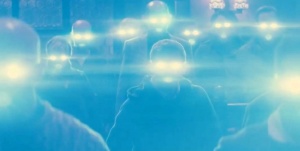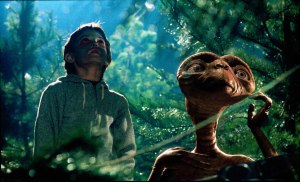This weekend finally sees the Canadian theatrical release of Under the Skin, Jonathan Glazer’s much-discussed sci-fi film starring babe-of-the-moment Scarlett Johansson as an alien seducing and killing men in Scotland. While the premise makes it sound like just another Species sequel – albeit with an A-list actress as the lead – Glazer’s music-video background and the film’s seeming impenetrability (or at least thematic complexity) gives the film an arthouse reputation that was sorely missing from the Natasha Henstridge-headlined franchise – or most other alien movies, for that matter. Indeed, works detailing extra-terrestrials invading, investigating, or otherwise visiting our precious planet usually fall into one of two categories – big-budget blockbuster or B-movie obscurity – making Glazer’s more enigmatic approach all the stranger. With that in mind, and for this week’s Top Ten Tuesday, I count down my favourite cinematic alien visitations.
 10. Independence Day (Roland Emmerich, 1996)
10. Independence Day (Roland Emmerich, 1996)
Emmerich’s jingoistic alien invasion blockbuster may seem quaint and outdated in our post-9/11 times, but back in the ’90s, its iconic imagery and rah-rah attitude felt perfectly at home. At once both a loving homage to atomic era B-movies and a big-budget FX extravaganza in its own right, it revitalized a flailing genre and made extra-terrestrials profitable again – not to mention kickstarting the career of the Fresh Prince himself. Rumours are that Will Smith won’t appear in the long-delayed sequel, due out in 2016 (just in time for the 20th anniversary); a shame, as his charismatic, smart-ass performance is one of the film’s timeless charms.
 09. The Day the Earth Stood Still (Robert Wise, 1951)
09. The Day the Earth Stood Still (Robert Wise, 1951)
A classic of the sci-fi genre: a humanoid alien named Klaatu and his robot bodyguard Gort arrive in Washington to warn humanity that our constant warring will not be tolerated by the galactic community, only to be largely ignored and dismissed by the political leaders of the day. To get our attention, Klaatu shows off his considerable power by ceasing all electronic activity worldwide, resulting in the titular event; of course, this demonstration is met only with fear and ignorance by the populace, causing Klaatu to become an alien outlaw. Though terribly dated, its anti-war sentiment is still as relevant as ever, and the idea of an alien visiting for purposes of peace is shockingly forward-thinking. Interestingly enough, its source text, a short story entitled “Farewell to the Master”, is even more thought-provoking, with a killer twist ending.
 08. The Man Who Fell to Earth (Nicolas Roeg, 1976)
08. The Man Who Fell to Earth (Nicolas Roeg, 1976)
Likely one of the cinematic progenitors of Under the Skin, and one of the few arthouse alien films, it stars David Bowie as a humanoid extra-terrestrial (a common theme) who crash lands on Earth searching for water to bring back to his drought-ridden planet. Less interested in the narrow confines of plot than exploring the strangeness of our planet when seen anew by an alien visitor, director Roeg indulges in surreal imagery and discontinuous editing to tell this story of the ultimate foreigner – a man who becomes seduced and corrupted by our most basic vices (alcohol and sex). Bowie, himself rather alien-looking, is simply perfect in the lead role, and the film’s fantastic visuals are stunning; though it was a commercial disappointment, it is now rightly seen as a cult classic.
 07. Invasion of the Body Snatchers (Don Siegel, 1956)
07. Invasion of the Body Snatchers (Don Siegel, 1956)
Though Philip Kaufman’s remake is a worthy successor, the original still reigns supreme, depicting Kevin McCarthy’s doctor gradually uncovering an extra-terrestrial conspiracy in his small town. Siegel’s method is deliberately unshowy, but his themes run deep, as the narrative’s vast network of pod people can be seen to stand in for either communism or McCarthyism; the film’s oscillation between either fearing the Red Menace or decrying those who do is a testament to its effectiveness, subtly indicating its intentions without overplaying its message. And the movie’s last shot, with McCarthy warning the audience itself that “you’re next!”, is a brilliant bit of fourth-wall breakage, terrifying the viewer in a manner unachieved by plentiful horror works.
 06. War of the Worlds (Steven Spielberg, 2005)
06. War of the Worlds (Steven Spielberg, 2005)
Extra-terrestrial expert Spielberg (his name shall recur) darkens things considerably for his alien invasion remake, trading on post-9/11 fears and anxieties in order to weave a frightening tale of foreign attacks and mass panic. Tom Cruise is predictably solid as a single father desperate to keep his children safe, but the real stars are the imposing visual FX, simultaneously awe-inspiring and all too real. When the alien tripods begin unleashing their death ray, literally vaporizing ordinary citizens and covering Cruise’s escaping protagonist in human ash, one cannot help but be reminded of the dust-covered figures on that fateful day in September – giving this ostensibly sci-fi tale a heavy dose of reality.
 05. The World’s End (Edgar Wright, 2013)
05. The World’s End (Edgar Wright, 2013)
Though released just last year, Wright’s capper to his so-called Cornetto Trilogy already has the hallmarks of a popular cult classic, between the critical acclaim, commercial disappointment, fantastic imagery, and bold themes. Drawing from the Body Snatchers films in its primary narrative of a small English town slowly replaced by ‘blanks’ – blue-blooded synthetic replicas of the human population – it, like Wright’s other works, merely uses the incredible plot as a parable to delve into more substantive or mature ideas – in this case, the notion that you can never truly go home again. In its tale of five friends returning to their hometown for a night of revelry and nostalgia, only to discover that things have irrevocably changed, the film incisively invokes contemporary feelings of longing and wistfulness, utilizing its alien invasion story as simply a high-concept metaphor.
 04. Close Encounters of the Third Kind (Steven Spielberg, 1977)
04. Close Encounters of the Third Kind (Steven Spielberg, 1977)
One of the first sci-fi works to remark upon the inherent strangeness of extra-terrestrial life, this alien abduction tale details what happens when a small group of people are influenced and controlled by something beyond their comprehension. Richard Dreyfuss is great as a blue collar worker in Indiana who cannot explain or even understand his bizarre behaviour following an encounter with a UFO, and famed French filmmaker François Truffaut impresses as a shadowy government scientist who knows more than he’s telling. The film’s climactic sequence and undisputed highlight, a moment of first contact at Wyoming’s Devils Tower, still excites after all these years with its majestic qualities – a thrilling combination of light, sound, music, and realization.
 03. Signs (M. Night Shyamalan, 2002)
03. Signs (M. Night Shyamalan, 2002)
Much-reviled director Shyamalan’s last positively-received feature is an intimate and frightening look at an alien invasion from the perspective of one broken family, starring Mel Gibson as a former priest questioning his faith and Joaquin Phoenix as his brother, a minor league baseball legend. Invoking stereotypical elements of perceived extra-terrestrial contact, such as crop circles and barking dogs, but wrestling with more weighty themes of fate and belief, Shyamalan again uses a fantastical narrative to tell a deeply personal story of loss and regret. Though his methods are rarely ambiguous and his intentions never in doubt, his Hitchcockian formal approach (complete with a Bernard Herrmann-esque score) grants the clichéd material an air of urgency and vitality, successfully imbuing the small-scale story with cosmic meaning.
 02. E.T. the Extra-Terrestrial (Steven Spielberg, 1982)
02. E.T. the Extra-Terrestrial (Steven Spielberg, 1982)
One of Spielberg’s greatest works, a light-hearted fable concerning a stranded alien and his efforts to return home, it’s one of the few alien visitation films to feature a completely benevolent extra-terrestrial, with only misunderstanding humanity causing violence and terror. Although sometimes interpreted as a Jesus Christ metaphor, the narrative is really about a single-parent family coming together in the wake of divorce and discord – a common theme throughout Spielberg’s oeuvre. At once both heartfelt and hilarious, showcasing E.T.’s fish-out-of-water antics and deep connection with middle child Elliot (Henry Thomas), it’s the rare movie to truly appeal to children and adults alike, making it no surprise that this is the highest-grossing film in the director’s storied career.
 01. The Thing (John Carpenter, 1982)
01. The Thing (John Carpenter, 1982)
Ironically released just two weeks after the previous film on this list, Carpenter’s re-imagining of the ’50s genre classic was soon overpowered by the E.T. box-office craze and disappointed commercially, grossing under $20 million domestically. A shame, as it’s a bona fide sci-fi and horror masterpiece, surpassing the original in every conceivable manner and standing as a paragon for two different cinematic genres. Though its horror elements – building tension, dazzling gore effects, and a great sense of uncertainty and unease – are more viscerally appealing, the science-fiction components of the narrative – notably, an alien visitor that can change its shape and very being into anything it touches – are far more philosophically fascinating, raising more questions than they answer and posing the query: “if the Thing can look like anything, what did it look like originally?”
